Newborn Screening Market Size
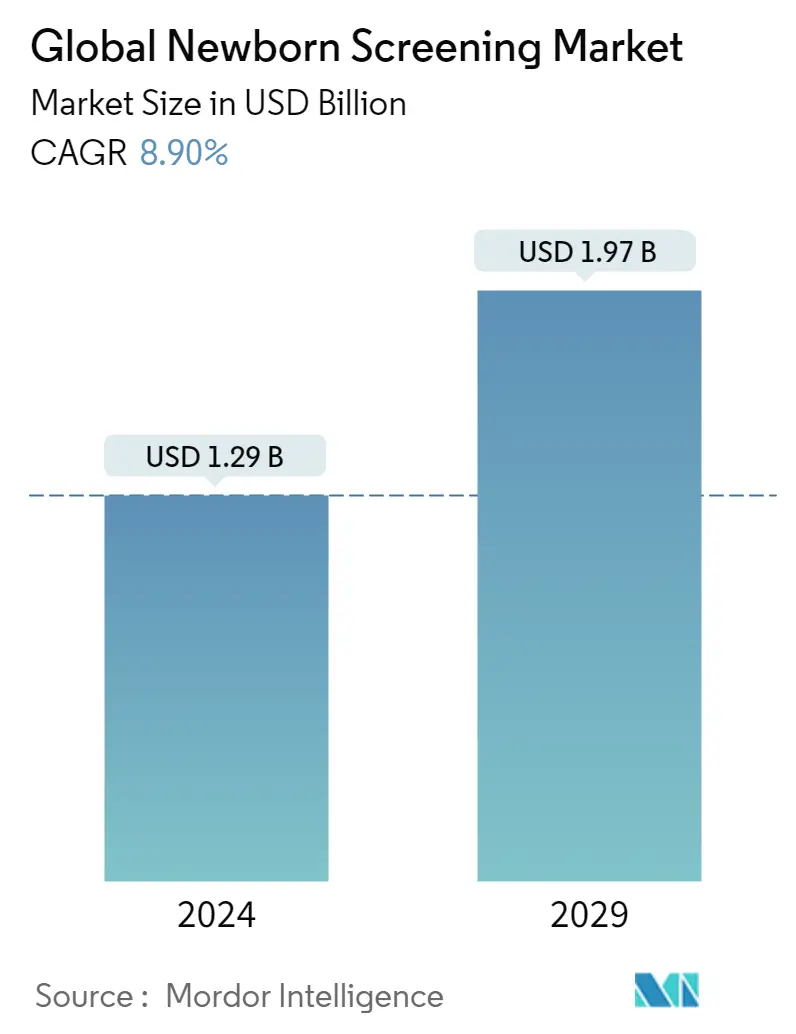
| Study Period | 2019 - 2029 |
| Market Size (2024) | USD 1.29 Billion |
| Market Size (2029) | USD 1.97 Billion |
| CAGR (2024 - 2029) | 8.90 % |
| Fastest Growing Market | Asia Pacific |
| Largest Market | North America |
Major Players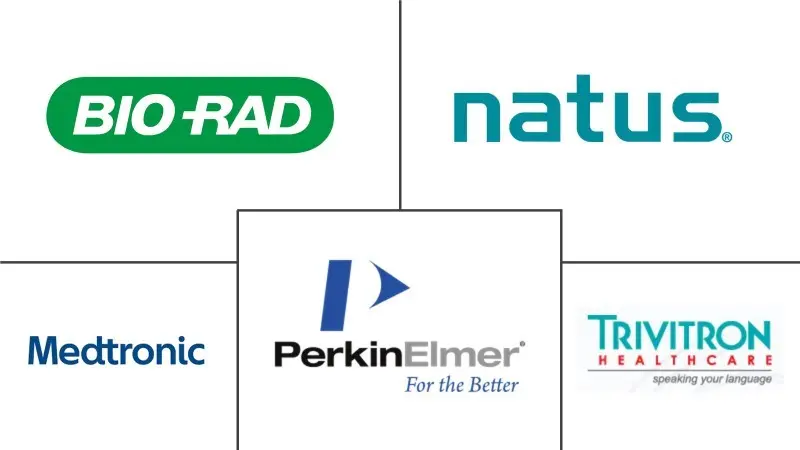
*Disclaimer: Major Players sorted in no particular order |
Newborn Screening Market Analysis
The Global Newborn Screening Market size is estimated at USD 1.29 billion in 2024, and is expected to reach USD 1.97 billion by 2029, growing at a CAGR of 8.90% during the forecast period (2024-2029).
The COVID-19 pandemic affected every aspect of the healthcare system around the world due to the high influx of COVID-19 patients owing to the high infectivity rate of the SARS-COV-2 virus. The newborn screening procedures were also impacted initially due to the diversion of resources towards COVID-19 management which is anticipated to have an impact on the market. For instance, according to a research study titled 'Global impact of COVID-19 on newborn screening programs' published in March 2022, most newborn screening centers responded that the pandemic created little effect (47.7%), 18.6% a moderate effect, and 12.8% a lot, while 16.3% of the centers reported no effect. Also, as per the same source, in 29 of the 38 countries that responded, COVID-19 had some effect on the newborn screening programs and most of the screening centers encountered a wide range of issues, and the majority were more negatively impacted by the pandemic's second wave. Hence, COVID-19 is expected to have a significant impact on the newborn screening market.
Factors responsible for the growth of the newborn screening market include growing newborn screening programs, rising incidences of congenital diseases, raising funding from government sectors for newborn screening, and advancements in technologies used in newborn screening. For instance, according to a research study published in April 2022, titled 'Epidemiology of Congenital Heart Disease in Jinan, China From 2005 to 2020: A Time Trend Analysis', in urban regions, the prevalence of congenital heart disease (CHD) was 4.81 per 1,000 births from 2005 to 2020, compared to 3.17 per 1,000 births in rural areas and the prevalence of CHD grew by 157.45% and 316.03%, respectively, in urban and rural areas between 2005 and 2020, according to a time trend analysis of the data. Similarly, according to the February 2022 data of the World Health Organization, an estimate, birth abnormalities are responsible for the death of about 240,000 newborns in the first 28 days of life each year across the glove and an additional 170,000 children between the ages of 1 month and 5 years die because of birth abnormalities. Hence, newborn screening becomes very important as it can provide a proper health analysis of newborns in determining various birth defects or diseases, which can be used to provide adequate medical attention to the newborn and save the life of the newborn. Thus, the demand for newborn screening is expected to increase which will fuel growth in the studied market over the forecast period.
Further, the newborn screening programs run by governments across the continent are expected to have a significant impact on the growth of the newborn screening market as several governments have made newborn screening compulsory before getting discharged from the hospital. For instance, according to the March of Dimes (MoD) report of 2021, before leaving the hospital, every baby in the United States receives newborn screening and the nation screens around 4 million newborns annually. Moreover, the technological advancement in newborn screening platforms and devices is also expected to have a significant positive impact on the newborn screening market over the forecast period. However, the lack of uniformity in newborn screening policies and procedures across the world, and a high number of false positive and false negative results from the tests are expected to restrain the newborn screening market during the forecast period.
Newborn Screening Market Trends
This section covers the major market trends shaping the Newborn Screening Market according to our research experts:
Dried Blood Spot Segment is Expected to Hold the Major Share in the Market Over the Forecast Period
The COVID-19 pandemic has created a massive demand for DBS newborn screening tests, which has led to the development of novel NBS tests during the pandemic. In July 2020, PerkinElmer Inc. launched a dry blood spot (DBS) based test for SARS-CoV-2 IgG using its GSP/DELFIA platform, enabling the processing of up to 5,000 samples per day. The DBS assay runs on PerkinElmer's GSP analyzer and, combined with the universal TRF (time-resolved fluorescence) of the DELFIA platform, screens more than 30% of all newborn babies worldwide, spanning 32 countries.
Dried blood spot tests (DBS) are expected to continue their domination during the forecast period. DBS sampling has been used to screen newborn babies for congenital metabolic diseases for over 50 years. The advantages of DBS sampling include minimal volume requirements (approximately 30 - 100 µL per spot), ease of sample attainment by finger or heel stick with minimal training required, and ease of transport and sample stability. Autism, lymphomas, leukemia, and many other metabolic conditions can be diagnosed through this test. Dried blood spot analysis offers the advantage of collecting a small sample volume, which can be easily transported. Thus, rising diseases in newborns are boosting market growth.
Additionally, few organizations and Academic institutes in the segment have been developing novel products and technologies to compete with the existing products. For instance, in March 2022, Oxford University initiated a population-based newborn screening study in the Thames valley. The screening will be done through the routine United Kingdom newborn blood spot screening pathway, using spare capacity from a newborn's Guthrie card (dried blood spot sample). Thus the factors mentioned above are expected to drive the growth of the studied segment during the forecast period.
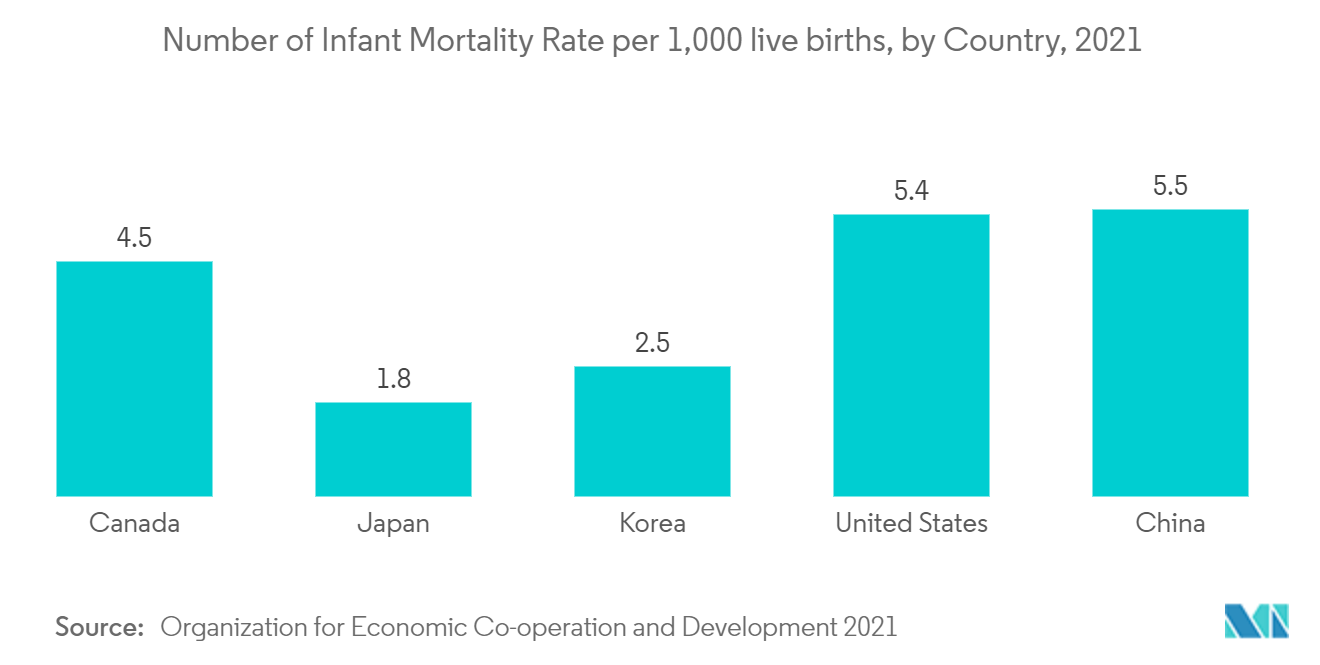
North America Region is Expected Occupy Major Share in the Market Over the Forecast Period
The North American region is expected to hold a major share in the newborn screening market owing to the high burden of birth defects in the region, government policies, the presence of robust healthcare infrastructure, and new technological developments in newborn screening technology by the players based in the region. For instance, according to a research study published in April 2022, titled 'Association of Birth Defects with Child Mortality Before Age 14 Years', birth defects were strongly associated with mortality owing to circulatory, respiratory, and digestive causes and the finding raises the possibility that the role of birth abnormalities in mortality numbers may be understated. The study was conducted in Canada and as per the same source, birth defects such as heart problems, chromosomal anomalies, and central nervous system disorders all increased the chance of death by more than ten times, eight times, and seventeen times, respectively, and the risk of death was significantly higher between days 28 and 364 of life, however, it was also higher at other times. Hence the demand for newborn screening in the region is expected to increase over time and the market is expected to grow in the region.
In the North American region, the United States is anticipated to hold the largest market share. This can be attributed to the increasing incidence rates of disorders in newborns and the rising demand for advanced systems. In the United States, every newborn is screened post-birth, and this screening is performed by the analysis of diagnostic markers in blood spots collected on filter paper on the second day of an infant's life. Newborn screening programs are run on a state basis within the United States; therefore, it has been observed that there is a lack of uniformity among the testing panels of many states. For instance, according to the data published by the Centers for Disease Control and Prevention, in 2022, about 3,613,647 new births were reported in the country, and the birth rate in the country 2022 was 11.0 per 1,000 population, and most of these birth in hospitals, thus, the screening is performed before babies' discharge. Further, the launch of new services and products in the region is expected to have a significant impact on the growth of the studied market. For instance, in June 2021, the Texas Health and Human Services launched newborn screening for Spinal Muscular Atrophy (SMA). Therefore, due to the above-mentioned factors, the newborn screening market is expected to have a significant market share over the forecast period.
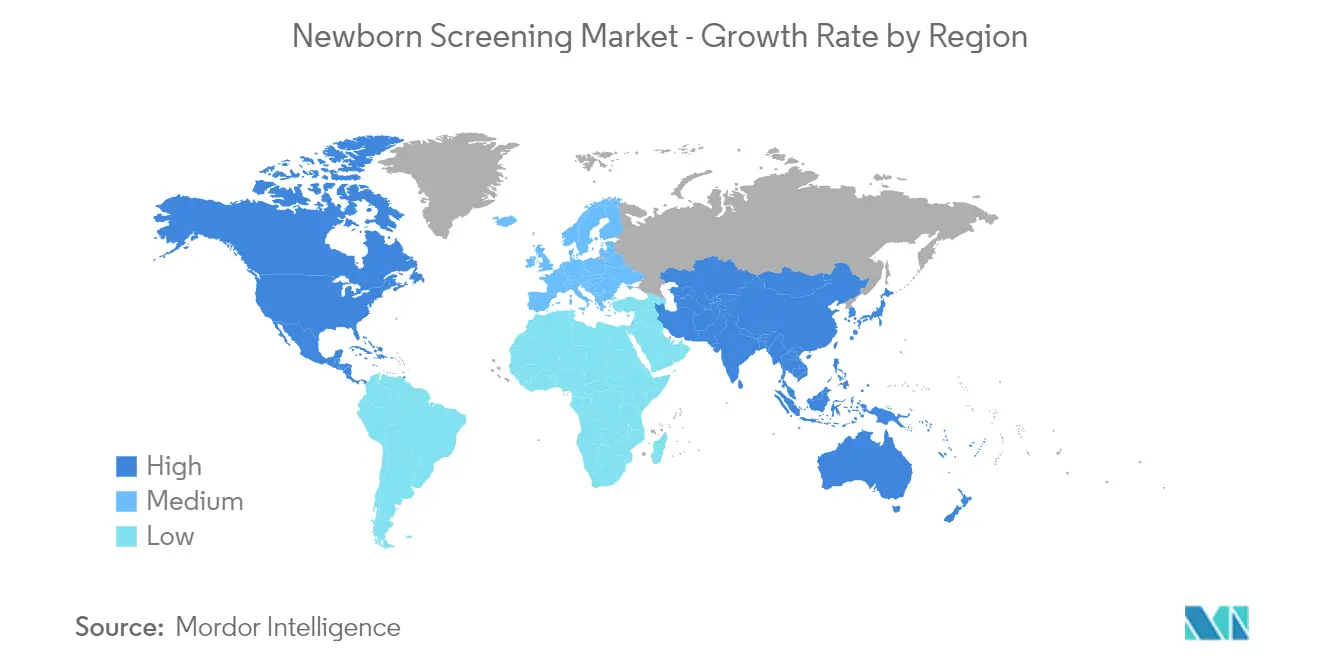
Newborn Screening Industry Overview
The newborn screening market is moderately competitive and consists of several major players. In terms of market share, few of the major players currently dominate the market. Some of the of key players in the market are Agilent Technologies Inc., Natus Medical Inc., Trivitron Healthcare, Medtronic Inc., Masimo Corp., and Bio-Rad Laboratories Inc., among others.
Newborn Screening Market Leaders
-
Natus Medical Incorporated
-
Trivitron Healthcare
-
Medtronic Inc.
-
Bio-Rad Laboratories Inc.
-
PerkinElmer
*Disclaimer: Major Players sorted in no particular order
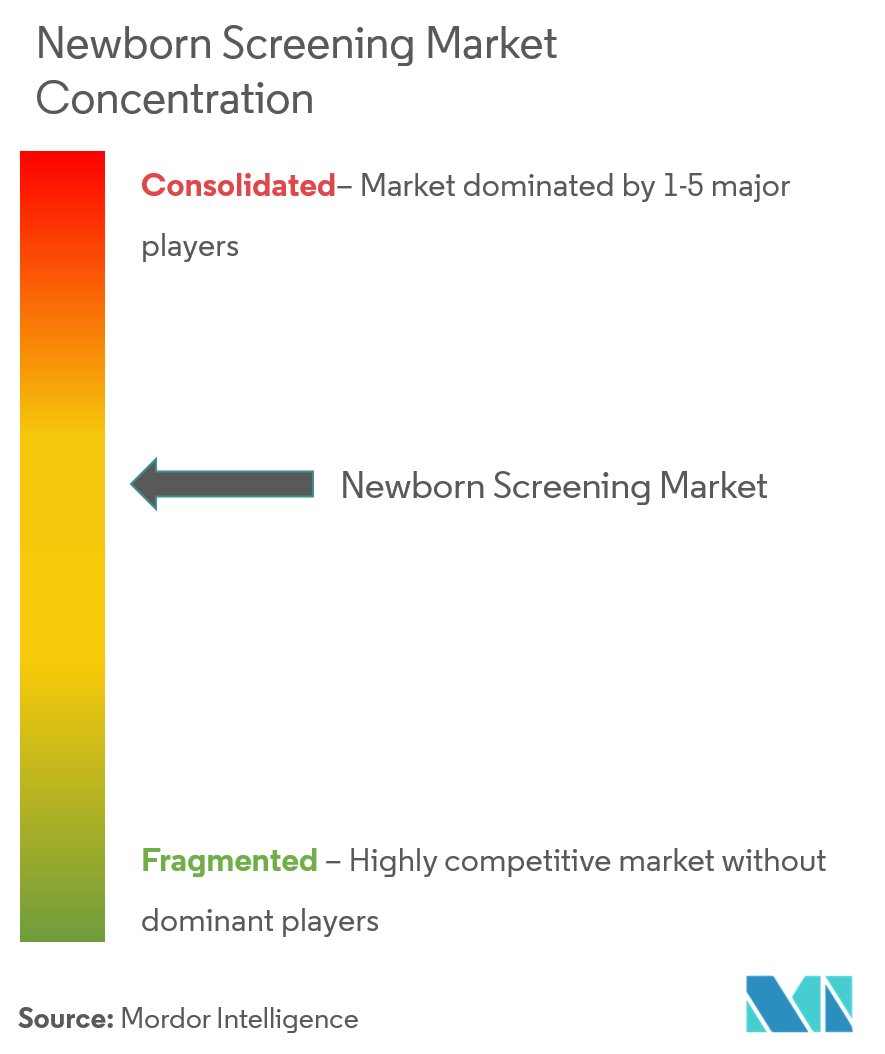
Newborn Screening Market News
- In August 2022, Trivitron Healthcare launched a Centre of Excellence (CoE) with state-of-the-art research and development and manufacturing facilities at AMTZ Campus, Vishakhapatnam, India, for metabolomics, genomics, newborn screening, and molecular diagnostics.
- In June 2022, Rady Children's Institute for Genomic Medicine launched a program to advance and evaluate the scalability of a diagnostic and precision medicine guidance tool called BeginNGS (pronounced 'beginnings') to screen newborns for approximately 400 genetic diseases that have known treatment options using rapid whole genome sequencing.
Newborn Screening Market Report - Table of Contents
1. INTRODUCTION
- 1.1 Study Assumptions and Market Definition
- 1.2 Scope of the Study
2. RESEARCH METHODOLOGY
3. EXECUTIVE SUMMARY
4. MARKET DYNAMICS
- 4.1 Market Overview
-
4.2 Market Drivers
- 4.2.1 Rising Burden of Congenital Diseases
- 4.2.2 Rising Funding from Government Sectors for Newborn Screening
- 4.2.3 Advancements in Technologies Used in Newborn Screening
-
4.3 Market Restraints
- 4.3.1 Lack of Uniformity of Newborn Screening Policies and Procedures Across the World
- 4.3.2 False Positive and False Negative Results
-
4.4 Porter's Five Forces Analysis
- 4.4.1 Bargaining Power of Buyers/Consumers
- 4.4.2 Bargaining Power of Suppliers
- 4.4.3 Threat of New Entrants
- 4.4.4 Threat of Substitute Products
- 4.4.5 Intensity of Competitive Rivalry
5. MARKET SEGMENTATION
-
5.1 By Technology
- 5.1.1 Tandem Mass Spectrometry
- 5.1.2 Pulse Oximetry
- 5.1.3 Enzyme Based Assays
- 5.1.4 DNA Assays
- 5.1.5 Other Technologies
-
5.2 By Test Type
- 5.2.1 Dried Blood Spot
- 5.2.2 Hearing Screening
- 5.2.3 Critical Congenital Heart Defect (CCHD)
- 5.2.4 Other Test Types
-
5.3 By End User
- 5.3.1 Hospitals
- 5.3.2 Diagnostic Centers
- 5.3.3 Other End Users
-
5.4 Geography
- 5.4.1 North America
- 5.4.1.1 United States
- 5.4.1.2 Canada
- 5.4.1.3 Mexico
- 5.4.2 Europe
- 5.4.2.1 Germany
- 5.4.2.2 United Kingdom
- 5.4.2.3 France
- 5.4.2.4 Italy
- 5.4.2.5 Spain
- 5.4.2.6 Rest of Europe
- 5.4.3 Asia-Pacific
- 5.4.3.1 China
- 5.4.3.2 Japan
- 5.4.3.3 India
- 5.4.3.4 Australia
- 5.4.3.5 South Korea
- 5.4.3.6 Rest of Asia-Pacific
- 5.4.4 Middle East and Africa
- 5.4.4.1 GCC
- 5.4.4.2 South Africa
- 5.4.4.3 Rest of Middle East and Africa
- 5.4.5 South America
- 5.4.5.1 Brazil
- 5.4.5.2 Argentina
- 5.4.5.3 Rest of South America
6. COMPETITIVE LANDSCAPE
-
6.1 Company Profiles
- 6.1.1 AB Sciex
- 6.1.2 Bio-Rad Laboratories Inc.
- 6.1.3 GE Healthcare
- 6.1.4 Masimo Corporation
- 6.1.5 Medtronic Inc.
- 6.1.6 Natus Medical Incorporated
- 6.1.7 PerkinElmer Inc.
- 6.1.8 Trivitron Healthcare
- 6.1.9 ZenTech SA
- 6.1.10 Demant A/S
- 6.1.11 Waters Corporation
- 6.1.12 Thermo Fisher Scientific
- 6.1.13 Hill-Rom Holdings Inc.
- *List Not Exhaustive
7. MARKET OPPORTUNITIES AND FUTURE TRENDS
** Subject To AvailablityNewborn Screening Industry Segmentation
As per the scope of this report, newborn screening is a preventive pediatric screening test conducted to diagnose congenital or inborn abnormalities of metabolism to identify the disease. The early detection and appropriate standards of diagnosis and treatment can prevent death and promote the healthy development of an infant. The newborn screening market is segmented by technology (tandem mass spectrometry, pulse oximetry, enzyme-based assays, DNA assays, and other technologies), test type (dried blood spot, hearing screening, critical congenital heart defect (CCHD), and other test types), end user (hospitals, diagnostic centers, and other end users), and geography (North America, Europe, Asia Pacific, Middle East And Africa, and South America). The Market report also covers the estimated market sizes and trends of 17 countries across major regions globally. The report offers values (in USD million) for the above segments.
| By Technology | Tandem Mass Spectrometry | |
| Pulse Oximetry | ||
| Enzyme Based Assays | ||
| DNA Assays | ||
| Other Technologies | ||
| By Test Type | Dried Blood Spot | |
| Hearing Screening | ||
| Critical Congenital Heart Defect (CCHD) | ||
| Other Test Types | ||
| By End User | Hospitals | |
| Diagnostic Centers | ||
| Other End Users | ||
| Geography | North America | United States |
| Canada | ||
| Mexico | ||
| Geography | Europe | Germany |
| United Kingdom | ||
| France | ||
| Italy | ||
| Spain | ||
| Rest of Europe | ||
| Geography | Asia-Pacific | China |
| Japan | ||
| India | ||
| Australia | ||
| South Korea | ||
| Rest of Asia-Pacific | ||
| Geography | Middle East and Africa | GCC |
| South Africa | ||
| Rest of Middle East and Africa | ||
| Geography | South America | Brazil |
| Argentina | ||
| Rest of South America |
Newborn Screening Market Research FAQs
How big is the Global Newborn Screening Market?
The Global Newborn Screening Market size is expected to reach USD 1.29 billion in 2024 and grow at a CAGR of 8.90% to reach USD 1.97 billion by 2029.
What is the current Global Newborn Screening Market size?
In 2024, the Global Newborn Screening Market size is expected to reach USD 1.29 billion.
Who are the key players in Global Newborn Screening Market?
Natus Medical Incorporated, Trivitron Healthcare, Medtronic Inc., Bio-Rad Laboratories Inc. and PerkinElmer are the major companies operating in the Global Newborn Screening Market.
Which is the fastest growing region in Global Newborn Screening Market?
Asia Pacific is estimated to grow at the highest CAGR over the forecast period (2024-2029).
Which region has the biggest share in Global Newborn Screening Market?
In 2024, the North America accounts for the largest market share in Global Newborn Screening Market.
What years does this Global Newborn Screening Market cover, and what was the market size in 2023?
In 2023, the Global Newborn Screening Market size was estimated at USD 1.18 billion. The report covers the Global Newborn Screening Market historical market size for years: 2019, 2020, 2021, 2022 and 2023. The report also forecasts the Global Newborn Screening Market size for years: 2024, 2025, 2026, 2027, 2028 and 2029.
Newborn Screening Industry Report
Statistics for the 2024 Newborn Screening market share, size and revenue growth rate, created by Mordor Intelligence™ Industry Reports. Newborn Screening analysis includes a market forecast outlook to 2029 and historical overview. Get a sample of this industry analysis as a free report PDF download.



